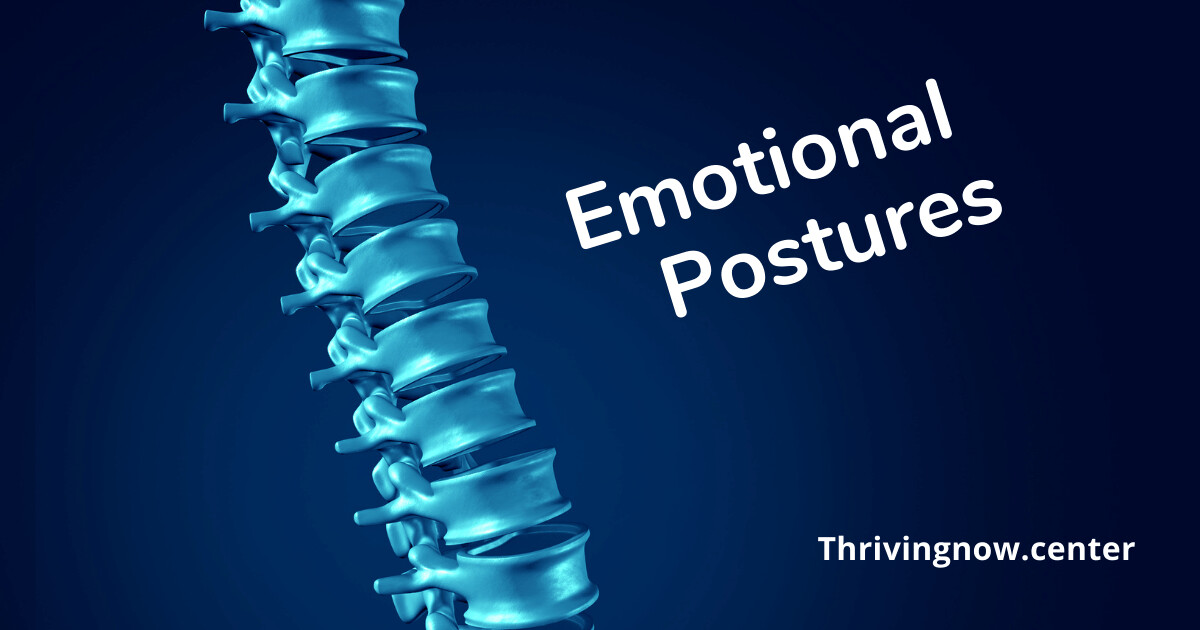Humans are emotional beings; that is one of our wondrous gifts. We love and live passionately through the emotions that flow through us.
We move from one emotional state to another. And sometimes we develop certain emotional states that we move into easily, just as we walk, stand, or sit a particular way. I call these “emotional postures.”
Some people stand straight and tall, with a physical posture that is balanced and strong. Some people slouch, with their back hunched, shoulders weak, and head bowed. Our physical body adopts certain positions out of habit, past injury, and repetitive movement (or lack of movement…).
Can posture be improved? Absolutely!
To improve posture requires awareness (“there is a problem”), a willingness to change (“I’d like to have better posture”), hope that it can be changed (“I can do this”), and a long-term plan combined with new skills and exercises.
Postural change requires persistent application of these skills and exercises over a period of time until the new posture becomes “habit,” and it is the old posture that feels unnatural and unbalanced.
Just like our physical body adopts certain postures, so too does our energy system. It is my theory that any emotion we feel “easily” and that feels comfortable “like an old shoe” to us, we’ve had a lot of practice feeling. Our energy system adopts the state easily, and while it may be a negative emotion, it nonetheless is a familiar one.
“Worried” and “angry” are emotional postures.
So are peevish, cynical, critical, lonely, unmotivated, ignored, friendless, untrusting, not-good-enough, unappreciated, and unloved. Let’s also include overwhelmed, frustrated, impatient, and stressed.
If a person demonstrates such a state of being on a consistent basis, it is an emotional posture. It has become how the person stands and relates to the world.
I used to be a worrier. I had plenty to worry about, of course. Most worriers have a list a mile long. What is interesting is that as I changed my emotional posture to be closer to “Don’t worry, Be Happy” (a song title I used to despise ), I noticed that my list of things I could worry about is just as long as it used to be. Only, my emotional posture is so different, I don’t process them in the same way.
When we change physical posture, we include practices such as stretching the short, tight muscles, strengthening the long, weak muscles, using massage to bring deep relaxation and relieve localized areas of pain, adding non-habitual movement to teach the nervous system new tricks, and heightening body awareness to catch us when we start “falling” into the old posture and to maintain the proper alignment.
When we seek to change emotional posture, we need to do similar exercises. We stretch ourselves emotionally by exploring feelings we don’t habitually feel anymore—like gratitude and savoring simple uplifts.
We strengthen our emotions through affirmations that acknowledge our painful truth while choosing a brighter, more peaceful present. We use EFT Tapping to address specific painful issues and to teach our energy system a new, faster resilience in the face of all daily stresses. And we bring awareness to our emotional state so that we catch ourselves before we fall into the old posture. We use EFT, meditation, movement, and other techniques to maintain proper alignment.
Does this sound like a lot to do on your own? Well, it is. I’ll be the first to admit that I love having help for myself and helping others.
We may idolize the rugged individualist, but I think suffering alone in silence so as not to appear weak is… unhelpful — damaging even.
It does take courage to seek, ask, and receive help. Just know that the purpose is never to make you dependent on other person’s support. Changing postures can feel strange and uncomfortable; professional support can help show you how and where to focus for maximum benefit, and it helps to reflect your progress back to you. The ultimate goal is for you to feel physically vital and emotionally free, with mental clarity and a spiritual connection that becomes your personal inner guide.
Our Thriving Now Circle is a group coaching program designed to help you establish powerful, new emotional postures… such as a feeling of surprising calm confidence… no matter what! If you are interested in making a shift in how you process life situations emotionally, we encourage you to try out this program. You can start your membership today.
Originally published Mar 17, 2008, revised Feb 24, 2021
